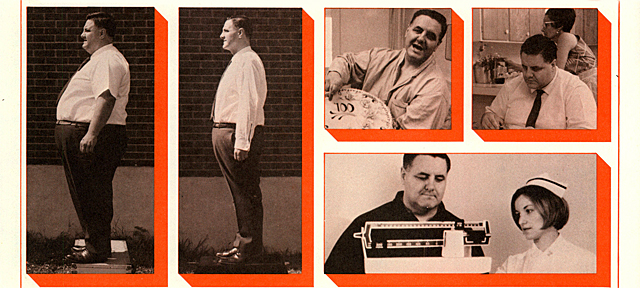
A Matter of Fat: Inside the Cruel and Unusual Crash Diets of the 1960s
A Matter of Fat: Inside the Cruel and Unusual Crash Diets of the 1960s
Diets have long thrived at the intersection of desperation and gullibility.
There was Fletcherizing, which claimed you could shed the pounds by simply chewing every single bite of food into liquid form, spitting out any recalcitrant bits. There was the tapeworm diet, which promised to slim you down by introducing a ravenous parasite into your gut. There was also the nicotine diet, which suggested you smoke your hunger away (cue Lucky Strike’s “Reach for a Lucky instead of a sweet” ad campaign); the Sleeping Beauty diet, which invited you to sleep away the pounds while under heavy sedation for several days (Elvis was reportedly a big fan); and, more recently, Breatharianism, an extreme proposition based on the notion that food is totally overrated and that all you need to thrive, really, is fresh air.
As Louise Foxcroft writes in Calories & Corsets: a History of Dieting Over 2,000 Years: “There have been other gurus, plans, drugs and devices, but most offer short-lived results and long-term angst.”
Gilles Lorrain, the man at the center of A Matter of Fat, a fascinating 1969 feature documentary about the ins and outs of the girth management industry, tried perhaps the most hard-core diets of them all: complete starvation. Lorrain, an obese 37-year-old Montrealer decided to address his weight issue after schoolchildren began mocking his kids on account of their father’s “grotesque” physique.
Distraught by his daughter’s tears, he took a decision not many would dare take: he checked himself into a hospital for the most drastic of treatments. For 30 days at a time, interspaced with weeklong calorie-controlled eating periods, Lorrain would be allowed nothing but water or black coffee. Not a single bite of food. The idea? Getting Lorrain’s 358-pound body to burn his own fat – 150 pounds of it.
The film, which follows Lorrain over the 7 months of his hospital stay, is a riveting watch. Much of this is owed to the patient himself. Lorrain, a candid, witty and ultimately endearing figure, carries the film with jest and gusto. One imagines a man in his condition would have reasons to be bashful, or guarded. Lorrain is everything but. Addressing the camera in a manner reminiscent of reality-TV, he affably discusses his weight (he says being overweight is like carrying a man on your back all the time), his sexuality (“sex is theoretical”), and the many-pronged impacts of starvation (he feels like his nerves are coming out of his skin).
Between regular check-ins with Lorrain, the film deftly explores a dozen or so germane topics. More often than not, these vignettes match Lorrain’s ordeal in terms of eyebrow raising power. There’s a segment with Life magazine’s Susanna McBee, who broke a story, in 1968, about being indiscriminately prescribed hundreds upon hundreds of diet pills despite her undeniably trim figure. (At the time, these pills were mostly some form of amphetamines, or “speed.”)
We also get to visit The Strangest People on Earth freak show, where we meet “Sweet Marie,” a 723-pound woman who introduces herself as “the youngest fat girl on exhibition.” Next to an insultingly porcine painting of her, on stage, a circular tag reads: “1/3 ton of fun!”
Other interludes include a “reducing camp” for overweight girls in the Catskills, and an early Weight Watchers meeting. It appears the world’s most famous weight loss company, created 5 years earlier, had yet to switch to its PointsPlus system. Both tomato sauce and wine were strictly forbidden at the time. “We at Weight Watchers get high on our own saliva!” the representative in the voluptuous beehive says.
You’ll have to watch the film to find out how much weight Lorrain manages to shed and how it all pans out. (As a reward, the last minutes of the doc offer a flabbergasting time-lapse of his progress.) Because despite the extreme and barbaric nature of his “treatment,” and the well-reported fact that 80% of all dieters eventually regain every single pound they drop, you really want Gilles Lorrain to succeed and finally be able to play with his children, freed once and for all from the man he’s been lugging around on his back.
A Matter of Fat, William Weintraub, provided by the National Film Board of Canada



This shows us the danger of over weight and the advantages of going for exercises. Friends please maintain a good food intakes and routine body exercises to stays alife.
They regain because the message is not accepted by the subconcious, if they take help of a hypnotherapist as well, so when they reduce weight they donot get it back and they reduce the weight in a healthy and nice way.
Is there any followup on this film about the main character Gilles? Is he still alive? If not, did he die of heart disease or diabetes?
Hi Belinda,
Gilles was my grandfather. He passed away in 2006 due to old age, but was obese at his time of death. He was a wonderful grandfather, and very loving man.
Take care,
Jessica